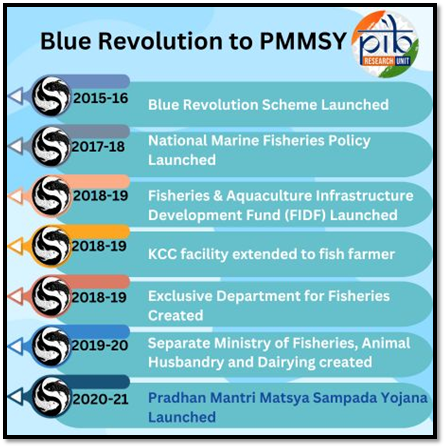-
24 Jan 2025
GS Paper 1
Geography
Day 47: "India has significant potential to emerge as a global leader in fisheries and aquaculture." Discuss the opportunities and challenges associated with the growth of this sector in the context of the Blue Economy.
Approach
- Briefly introduce India’s potential in fisheries and aquaculture in the context of the Blue Economy.
- In the body, outline the opportunities India has to emerge as a global leader, followed by the challenges hindering growth.
- Conclude suitably.
Introduction
India, with its vast coastline, extensive inland water bodies, and rich marine biodiversity, is a global leader in fisheries and aquaculture, ranking as the second-largest aquaculture producer and third-largest fish producer. The sector not only supports the livelihoods of 30 million people, particularly in rural and coastal areas, but also has immense potential for contributing to food security, exports, and rural development, aligning with the Blue Economy vision.
Body
Opportunities in Fisheries and Aquaculture
- Growing Contribution to Global Seafood Supply:
- India is one of the world’s largest shrimp producers, contributing significantly to seafood exports, with earnings of ₹ 60,523.89 crore during FY 2023-24.
- The inland fisheries sector now accounts for 70% of total fish production, showcasing a transformative shift.
- Government Support and Initiatives:
- Pradhan Mantri Matsya Sampada Yojana (PMMSY): Aims to increase fish production to 22 million metric tons by 2024-25, improve infrastructure, and promote sustainable practices.
- Marine Fisheries Census: Enables data-driven policymaking for resource management.
- Blue Revolution Scheme: Focuses on increasing productivity and creating employment.
- FIDF (Fisheries and Aquaculture Infrastructure Development Fund): Supports infrastructure creation with financial assistance.
- Technological Innovations:
- Adoption of recirculatory aquaculture systems (RAS) and biofloc technology enhances productivity while reducing resource use.
- Single Window System simplifies coastal aquaculture farm registration.
- Promising Areas for Growth:
- Expansion of brackish and saline aquaculture (only 13% of 1.42 million hectares currently utilized).
- Promotion of cold water fisheries (e.g., omega-rich trout) in Himalayan states.
- Global Leadership through Initiatives:
- Development of a Voluntary Carbon Market Framework aligns with sustainable Blue Economy goals.
Challenges in Fisheries and Aquaculture
- Overfishing and Marine Resource Depletion: Unsustainable practices threaten biodiversity and long-term productivity.
- Climate Change Impacts: Rising temperatures and ocean acidification disrupt fish habitats and breeding cycles.
- Limited Seaweed Varieties: PMMSY aims for 1.12 million tonnes of seaweed by 2025, but overreliance on declining Kappaphycus alvarezii necessitates importing new varieties to boost productivity.
- Infrastructure Deficits: Post-harvest losses of 20-25% due to lack of modern cold chains and processing units.
- Pollution and Habitat Degradation: Coastal and marine pollution, including plastics, harm ecosystems.
- Regulatory and Market Challenges: Ineffective enforcement of fishing regulations and stringent quality standards in export markets (e.g., EU) limit growth.
- Limited Utilization of Resources: Vast brackish and saline lands remain underutilized despite significant potential.
- Fishing Disputes: Frequent disputes over fishing rights in the Palk Strait disrupt livelihoods, strain bilateral ties, and affect sustainable fishery production in India's southern coastal regions.
Conclusion
India's fisheries and aquaculture sector is key to its Blue Economy goals. With government support and innovation, India can lead globally by tackling overexploitation, climate change, and infrastructure gaps while promoting sustainability. Leveraging its resources ensures contributions to food security and inclusive, sustainable growth.





